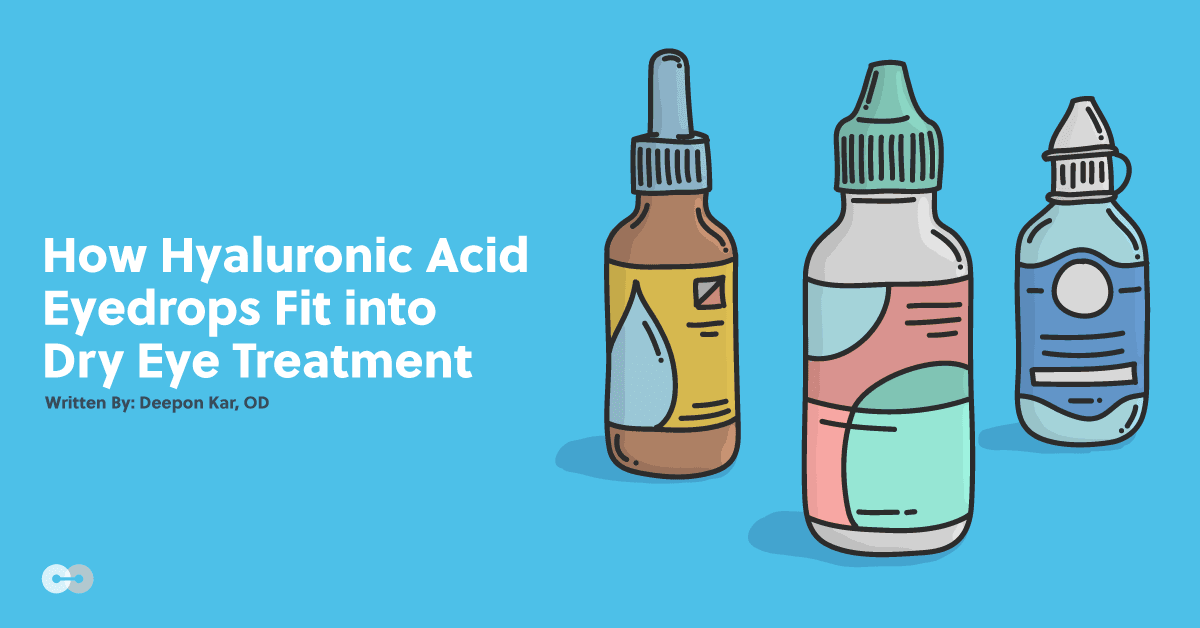First, a couple of important reminders:
- TFOS DEWS II defines dry eye disease (DED) as a multi-factorial disease characterized by the loss of homeostasis of the tear film by tear film instability, hyperosmolarity, and ocular surface inflammation.
- Preservative-free (PF) eyedrops are strongly recommended over eyedrops containing preservatives because studies have shown particular additives like benzalkonium chloride (BAK) and polyquaternium (Polyquad) can act as pro-inflammatory agents where they work as a detergent and break up the lipid layer of the natural tear film, causing tear film instability and toxicities to the corneal surface.1
The deal with hyaluronic acid (HA)
- HA has a strong affinity for water molecules, allowing for a high ability to bind and retain water molecules, increasing ocular surface wettability and reducing tear evaporation.2
- HA has high viscoelasticity, which reduces the friction between the cornea and eyelids during blinking thus reducing mechanical stress and damage to the cornea.2
- Clinical studies have shown that HA promotes healing of corneal epithelial abrasions by stimulating epithelial cell adhesion, proliferation, migration, and overall epithelial healing.2
Factors that need to be considered in HA eyedrops
Osmolarity
Molecular weight
- HMWHA allows for higher retention of water and secretory mucin in the aqueous layer of the tear film due to having a larger chain length. This reduces friction between the eyelids and ocular surface and reduces ocular surface damage and inflammation.5
- HMWHA has anti-inflammatory effects while LMWHA elicits inflammatory effects. Due to HMWHA being a larger polymer, it is able to maintain secretory mucin expression, and protect the lacrimal glands and goblet cells against pro-inflammatory markers which stabilizes the tear film.
HA concentration
How HA compares to other common artificial tear ingredients known to alleviate DED
| Preservative-Free Eye Drops | Key Ingredients | Expiry After Opening |
|---|---|---|
| Hyabak | 0.15% sodium hyaluronate: natural hypotonic solution | 3 months |
| Thealoz DUO | 0.15% sodium hyaluronate: natural hypotonic solution, 3% trehalose | 3 months |
| Thealoz DUO GEL | 0.15% sodium hyaluronate: natural hypotonic solution, 0.25% carbomer, 3% trehalose | 3 months |
| HYLO | 0.10% sodium hyaluronate | 6 months |
| HYLO DUAL | 0.05% sodium hyaluronate, 2% ectoine (acts as an osmolyte), a borate buffer, and water | 6 months |
| HYLO GEL | 0.20% sodium hyaluronate, a citrate buffer, sorbitol, and water | 6 months |
| iDROP PUR | 0.18% viscoadaptive hyaluronan (hyaluronic acid and glycerin) | 12 months |
| iDROP PUR | 0.18% viscoadaptive hyaluronan (hyaluronic acid and glycerin) | 12 months |
| iDROP GEL | 0.30% hyaluronic acid, glycerin | 12 months |
| iDROP MGD | 0.20% hyaluronic acid with added glycerin, osmoprotectants | 12 months |
| Evolve Daily Intensive | 0.2% sodium hyaluronate, sodium chloride, borate acid, water | 3 months |
| Evolve Intensive Gel | 0.2% sodium hyaluronate, 0.2% carbomer, glycerol, sorbitol, sodium chloride, water | 3 months |
| HydraSense | 0.15% hyaluronic acid, sodium chloride, sodium citrate dihydrate, citric acid anhydrous, water | 12 months |
| HydraSense Advanced | 0.15% hyaluronic acid, Provitamin B5, sodium chloride, sodium citrate dihydrate, citric acid anhydrous, water | 12 months |
| HydraSense Night Therapy | 0.30% hyaluronic acid, sodium chloride, sodium citrate dihydrate, citric acid anhydrous, water | 12 months |
JUST RELEASED: The 2025 Dry Eye Report
Get insights from hundreds of optometrists in the highly-anticipated 2025 Dry Eye Report! Explore trends, treatments, tools, and advice to help you stay ahead in dry eye management, all for FREE! Click here to download!
References
- Steven DW, Alaghband P, Lim KS. Preservatives in glaucoma medication. Br J Ophthalmol. 2018 Nov;102(11):1497-1503.
- HA: No Laughing Matter (2018): https://www.reviewofoptometry.com/article/ha-no-laughing-matter.
- Aragona P, Di Stefano G, Ferreri F, et al Sodium hyaluronate eye drops of different osmolarity for the treatment of dry eye in Sjögren's syndrome patients.British Journal of Ophthalmology 2002;86:879-884.
- Comparing preservative free eyedrop products in Canada and looking beyond (2020): https://www.drmikng.com
- Kojima T, Nagata T, Kudo H, et al. The Effects of High Molecular Weight Hyaluronic Acid Eye Drop Application in Environmental Dry Eye Stress Model Mice. Int J Mol Sci. 2020;21(10):3516.
- You IC, Li Y, Jin R, Ahn M, Choi W, Yoon KC. Comparison of 0.1%, 0.18%, and 0.3% Hyaluronic Acid Eye Drops in the Treatment of Experimental Dry Eye. J Ocul Pharmacol Ther. 2018;34(8):557-564.
- GOMES, J.A.P. et al. Sodium hyaluronate (hyaluronic acid) promotes migration of human corneal epithelial cells in vitro British journal of ophthalmology, v.88, n.6, p.821-825, 2004.
- Aequus Eye Care (2021): https://www.aequuseyecare.ca
